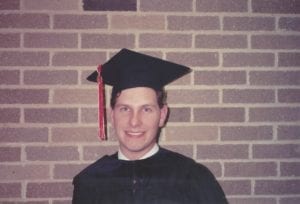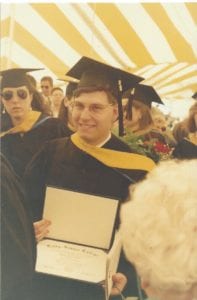Living with Klinefelter Syndrome: Part 4
My parents knew something about my anger, temper, quiet, and shyness, and not achieving the same as my peers at the same time that wasn’t right. They had no idea what was occurring until I received my KS/XXY diagnosis in February 1996.
Throughout my life and before my diagnosis, I saw many psychologists, psychiatrists, therapists, and physicians to determine why I was having so many issues in school with learning, socially, behaviorally, and with extensive mood changes. They could not determine anything specific while testing me for everything from A-Z. My testing began as early as 1973 and continued through the late 1980s.
Klinefelter Syndrome was not even considered since it was so rare and unheard of then. Even now, as I rewrote my story in 2019, KS/XXY still isn’t a mainstream condition that you might equate with Autism, Down Syndrome, Cancer, or many other well-known medical conditions. The only significant thing throughout the testing was the variety of learning differences that I had, which created many problems during my schooling years.
My learning differences consisted of reading comprehension, abstract thinking, understanding of non-visual materials, word retrieval, some slight memory retrieval, auditory processing, and the taking of standardized testing. I was meant to feel inferior and stupid by some of my teachers in elementary, middle, and high school. I was bullied by classmates and peers and was very immature for my age. I got into dangerous situations because I wanted friends and would do whatever someone asked me to do if they were my friend. My self-esteem was low. I felt confused and didn’t know how to handle myself in those schooling years.
In second grade, I was told by my primary teacher that I would never amount to anything. In seventh grade, a psychologist told me that I would probably live at home forever, never have a good job, and never be successful. Imagine being told that as a vulnerable young boy and teenager! After being told those things, I was convinced that I just needed to prove to everyone wrong who said I would fail. It has been a very redeeming quality of my life to show those downers that I could make it despite being told I was a loser.
These learning differences still affect me today, even as a 48-year-old adult. These learning differences affect me in one way or another. Still, during my first year of college, I decided I needed to figure out how to compensate for my learning differences. There had to be a method that I could rely on to survive life and be successful.
I spent a lot of time during my first few years of college figuring out how to fix my learning issues and not having them be a way of stopping me from succeeding and living my life. Eventually, I realized why do I need to fix my deficits. I can work around them and focus on the positives and strengths. So, I had to figure out my strengths and how I plan to focus on my best facets of learning. What I found as strengths work for me may not work for others, as it’s genuinely figuring out your learning style and modifying it for yourself. I must focus on visualization, repetition, and hands-on learning. Sounds easy, right?
I found that if I was shown something, even only once, I could continue to do it. I could adapt that style to whatever I was doing. Repetition, meaning lots of reading, and especially re-reading. Re-reading something three times allows me to grasp and understand the concepts and meanings fully. I can’t say it was easy, especially throughout college, re-reading hundreds of pages between classes. But it was certainly effective and more straightforward than the alternative, failing! Visualization, to me, is a concrete way of thinking. I do not do well with abstract thinking and concepts. If I didn’t visualize what I needed to do, whether for school or working in my adult life, I would struggle and have to spend a lot of time thinking about what I was being asked to do.
A number of things in my adult life would not be possible without those learning strategies that I developed to figure out a way of going forward with my life.
 During my six-year journey throughout college, which began in the fall of 1989 at a community college outside of Baltimore, Maryland, I experienced many things. I worked almost full-time while in community college. I was still undiagnosed with Klinefelter Syndrome at this time. I still struggled socially and emotionally, had anger issues, and didn’t feel I was as mature as my peers around me.
During my six-year journey throughout college, which began in the fall of 1989 at a community college outside of Baltimore, Maryland, I experienced many things. I worked almost full-time while in community college. I was still undiagnosed with Klinefelter Syndrome at this time. I still struggled socially and emotionally, had anger issues, and didn’t feel I was as mature as my peers around me.
I spent three years at this particular college, graduating with an A.S. in Business Administration in May 1992. I took many classes in many different areas to fulfill many required classes. Still, I also took exciting classes and experimented with other courses. For instance, the class where I took an absence not to have to verbally answer questions when it was my required college Science course, Meteorology. It was taught by a local meteorologist and was a great class. I had decent grades, not outstanding, but better than in high school. I was working on perfecting my learning strategy methods, and that allowed me to experiment with different situations and scenarios.
While at the community college, I saw a college career recruiting specialist to try and figure out the best place to transfer to after completing my Associate’s degree. Remember, this was before the internet existed, so going online to find colleges that best fit my skills and what I wanted to do for the rest of my life wasn’t relatively as easy.
Through my career specialist and various career tests, we determined a list of 10 colleges to consider. Through library research and knowing that I wanted to go to New England to finish up my Bachelor’s Degree, I focused on schools up there and then researched in the library and reviewed the materials the career specialist had prepared for me. I planned a trip with my parents to visit seven schools, the majority being small colleges I had not heard of previously.
I ended up choosing Colby-Sawyer College in Central New Hampshire. It was a small 600-student Liberal Arts college that I attended from September 1992 through May 1995. It has more than doubled in size since then. Colby-Sawyer College was an all women’s college through 1990. It would not have been possible to attend right out of high school. I chose this college because it had all the academics I was looking for and plenty of social activities for students on campus and in the area. I was looking for a small school and not looking to be invisible. I wanted to grow socially, emotionally, and educationally. Found exactly what I was looking for and made lifelong friends. Though I don’t see them often in person, the internet and social media have made it much easier to stay in touch.
I learned a lot about myself and who I was, perfected my learning compensation strategies, and became a functioning member of society.
Colby-Sawyer College was 500 miles from where I grew up, and it was my first experience leaving home and being primarily on my own. I graduated in May 1994 and May 1995 with dual Bachelor of Science degrees in Business Administration and Sports Management. Though my educational goal changed from my first attending Colby-Sawyer College and graduating from here, I got an excellent education and have applied it to my lifelong career. During my time at Colby-Sawyer College, I achieved some unbelievable educational accomplishments. I made Dean’s list for the first time ever. I had a 4.0 semester, only one, but that’s an accomplishment for me. I achieved honors in several semesters and never had one semester where my GPA was below 3.0! Though it wasn’t a storybook ending, I graduated within 2/100ths of a point from graduating cum laude. So much for only getting 680 on my SATs!!!
My first year out of college was confusing. It was a year when I was trying to figure out where I belonged in the world and life after college. It was during this year that I received my Klinefelter Syndrome diagnosis.
Continued in Part 5: Living with Klinefelter Syndrome

